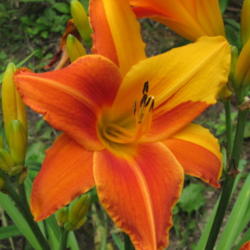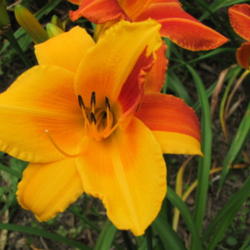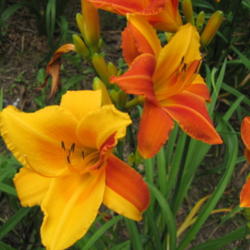Just adding two-cents on dividing or leaving as is.

First, you may want to tag the scapes in some way to make sure you have an ID for each while you take time to decide what you'll do (in case the blooms fall off and make it hard to remember which was what). If you might end up keeping them as a clump, then you'd probably want some more permanent way to be sure which fan was which by perhaps putting ID markers in the ground right next to each fan.
Since this may be a rather important set of daylily fans, especially the possible yellow-sport with faint red edge and eye, I'd wonder if you might want to maximize your chances that nothing unfortunate happens to them, though. I was reading about a wonderful 3+ years old seedling clump that ATP member Spunky had bred, for example, and before he could introduce it the clump was surprisingly and suddenly lost to crown rot at the end of summer. I know I also have lost very otherwise healthy daylilies to unusual and completely unexpected circumstances. So, at the very least, perhaps an inexpensive chicken-wire type "cage" to protect it from critters (you can get it in green, too, and it blends right in to the garden greenery). Along the way, if you decide you can bear to dig-and-divide, documenting that the yellow-flowered fan is a sport from the same crown or rhizomes as the original would establish the unique nature of that one fan, and if the stripe-split-color fans are something you end up wanting to register or introduce, you'll likely divide them eventually anyway, too.
If it were me, I might want to have the fans separated at least by type ("normal," possible yellow sport, and split-color) so that it would be easier to track each type. And, if you can stand to put them into one-fan-each areas that are very protected, it might increase the chance that one or the other fans would fare well? Since it is a dormant daylily, I'd try different locations in the garden where cultivars have done well and shown that there is excellent drainage, winter snow insulation, sun exposure, etc. To dig and divide them, I'd work very carefully to dig as wide and deep as possible to avoid disturbing roots too much, and work very slowly and gently to either untangle the particular crowns from each other if they are perhaps separate plants from seed (or cut them apart as needed if they are connected to the original plant as sport or otherwise). There are a few step-by-step accounts of how to divide daylilies successfully, if that is of interest.
http://garden.org/thread/view_...
http://garden.org/ideas/view/C...
http://garden.org/ideas/view/c...
http://garden.org/ideas/view/d...
I would especially consider doing that for the yellow flower sport, since it would be uniquely rare to daylilies as far as we know right now, but cannot be shown for sure unless it is examined at the crown or underground rhizome level, I believe. And, it would be hard to tell if it were producing reverted blooms the next time it sends up a scape if it is left in the clump and an ID gets lost over winter. Again, perhaps consider getting some chicken wire and sturdy stakes to anchor it, even to isolate it within the clump if you decide not to divide, in order to fashion a protective "cage" for it?
Again, just two-cents worth, since you are asking.

I'm sure they will be fine whatever way you handle it, and any photos or video that you take can document for posterity, even if you don't confirm the possibility of a first-ever sport by digging and dividing. The photos alone are valuable for their educational contribution, even if only to show precedent if and when someone finally demonstrates that a sport has occurred in the daylily world.



